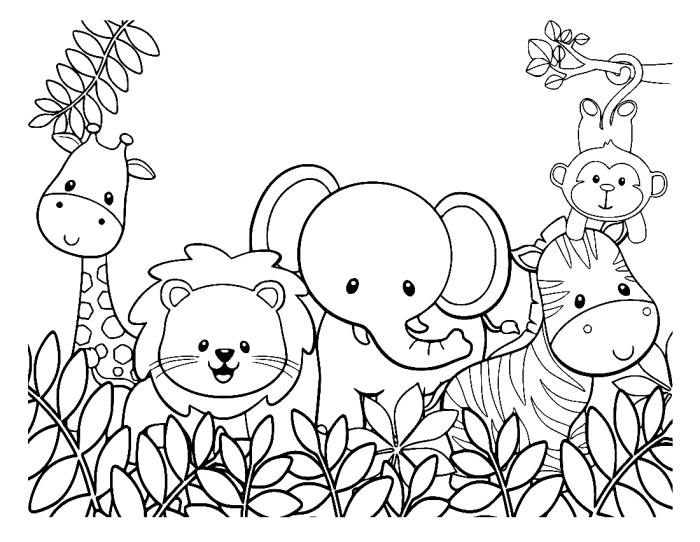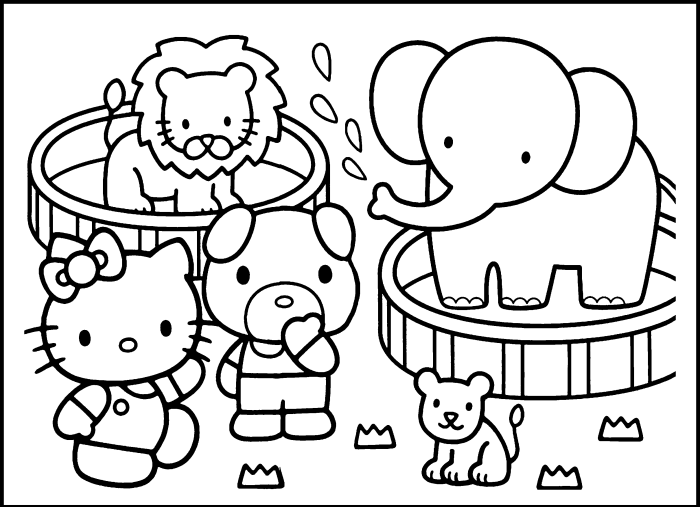Target Audience Analysis

Simple zoo animal coloring pages – Right, so, let’s get this sorted. These zoo animal colouring pages? They’re dead simple, innit? We need to figure out who’s gonna be using them, and what they’re all about.These colouring pages are, like, mega-basic. We’re talking proper simple designs, perfect for little ones who are just starting to get the hang of holding a crayon.
Think big, bold Artikels, not loads of fiddly bits. It’s all about easy fun.
Age Range
The main peeps who’ll be using these are, probs, ages two to five. Little kids, basically. They’re at that age where they’re starting to get a grip on colouring and drawing, and zoo animals are, like, mega-popular with that age group. You know, lions, tigers, and bears… oh my! They’re also at an age where their fine motor skills are developing, so the simplicity of the designs is key.
Older kids might find them a bit, well, – basic*.
Skill Level
These are definitely for complete beginners. We’re talking toddlers and preschoolers here. No need for shading or blending – it’s all about filling in the spaces with bright colours. Think primary colours – red, yellow, blue – that sort of thing. It’s all about getting them creative and expressing themselves without getting frustrated by complicated designs.
It’s like, colouring for absolute newbies, you know?
Interests and Preferences
Little kids are generally obsessed with animals, and zoo animals are right up there. Think bright, colourful animals. Lions, monkeys, giraffes – the classic zoo crew. They love recognisable animals, not some weird, obscure creature. Simple, fun, and easy to colour.
Plus, there’s a good chance they’ve actuallyseen* these animals at a real zoo, which makes it even more exciting for them. It’s like bringing the zoo home, innit?
Design Elements of Coloring Pages

Right, so we’re making some sick coloring pages for little ‘uns, yeah? Gotta make ’em proper lush and appealing, something that’ll get them off their screens and onto some proper creative vibes. Think bright colours, simple designs, and animals they’ll actually
want* to colour in.
Suitable Zoo Animals
Choosing the right animals is mega important, innit? We need critters that are easy to draw, but still look ace. Too much detail and it’ll be a nightmare for tiny hands. Too simple and it’ll look, well, rubbish. So, here’s a few ideas that totally nail it:
- Lion: A classic, and kids love ’em. Easy to draw a simple mane and body.
- Elephant: Big, chunky, and iconic. Perfect for bold colouring.
- Giraffe: Those long necks are a laugh, and the spots provide loads of colouring opportunities.
- Monkey: Fun and playful, monkeys are always a winner. A simple design is all you need.
- Zebra: Stripes are ace for kids to follow, and it keeps things simple.
- Penguin: Cute and cuddly, penguins are a bit different and add some variety.
- Tiger: Stripes again, but a bit more fierce than the zebra. Good for slightly older kids.
Layout Options for a Single Animal Coloring Page
Here’s how we can make the page look mint. Different layouts keep things interesting, so the little ones don’t get bored. We’ll use a 2×2 grid to show you some options for a single animal, like a lion, for example.
Simple zoo animal coloring pages are perfect for younger artists, offering a fun introduction to creative expression. But if you’re ready for a more intricate challenge, why not try something more detailed? You can find a fantastic resource for more advanced coloring with a mandala animal coloring book pdf free download. Afterward, you might even find yourself returning to those simpler zoo animals, appreciating their charm all the more!
| Layout 1: Central Animal The lion is smack-bang in the middle, leaving plenty of space around it for colouring. Maybe add some simple grass or a sun at the bottom. |
Layout 2: Animal in a Frame The lion is inside a simple square or circle frame. This adds a bit of structure and makes it easier to stay within the lines. |
| Layout 3: Animal with Simple Background The lion is surrounded by simple elements, like some basic trees or rocks. Keeps it engaging without being too complex. |
Layout 4: Large Animal, Small Details A big lion taking up most of the page, with small details like paws or a tail emphasized. Provides space for big bold colours. |
Line Art Style
The line art needs to be spot on. Too thick and it’ll look clunky, too thin and it’ll be hard for little ones to colour within the lines. We’re aiming for a simple, clean style that’s easy to follow. Think bold lines, about 2-3mm thick, with minimal detail. Avoid intricate patterns or tiny details – we want something that’s easy to colour in, even for the youngest of artists.
Think bold, simple shapes and easy-to-follow Artikels. No need for shading or complex textures; this is all about the colour!
Color Palette Suggestions: Simple Zoo Animal Coloring Pages

Right, so we’re talking colour palettes for our wicked awesome zoo animal colouring pages, innit? Gotta make ’em pop, but also keep it chill enough for little ones to get stuck in. Think bright, but not blinding – you know the vibe.We need palettes that are gonna get those creative juices flowing. Different colours create different feels, like, a bright orange lion could be totally fierce, while a pastel pink one might be all cute and cuddly.
Get it?
Color Palette Examples and Moods
Here’s the lowdown on five ace colour palettes perfect for our little animal friends:
- Pastel Rainbow: Think soft pinks, blues, yellows, and greens. This palette is all about creating a calm and happy vibe. It’s super versatile and works well for most animals.
- Jungle Greens: This one’s all about lush greens, browns, and maybe a splash of vibrant yellow or orange. Perfect for monkeys, parrots, and other jungle critters, giving a sense of adventure and excitement.
- Ocean Blues: Deep blues, turquoise, and sandy yellows create a tranquil underwater scene, ideal for sea creatures like dolphins, whales, and colourful fish. Evokes a sense of peace and wonder.
- Safari Sunset: Oranges, reds, yellows, and browns create a warm and inviting feeling, reminiscent of an African sunset. Great for lions, giraffes, and elephants; suggests warmth and adventure.
- Arctic Chill: Whites, blues, and light greys capture the icy beauty of the Arctic. Perfect for polar bears, penguins, and other cold-weather animals. It’s all about calmness and a sense of quiet beauty.
Color Gradient Example
Let’s say we’re doing a giraffe. Instead of just one shade of brown, we could use a colour gradient. Imagine starting with a light, sandy brown at the giraffe’s belly, gradually darkening to a rich, almost chocolate brown along its back. This adds depth and realism to the illustration, making it more engaging for the kiddos to colour in.
It also teaches them about shading and how light affects colour. Think of it as a smooth transition from light to dark brown, creating a natural look. The light brown could even subtly shift into a yellowish tone near the belly to add warmth and vibrancy.
Illustrative Examples
Right, so we’re gonna get into the nitty-gritty of what these colouring pages should actuallylook* like. Think simple, think bold, think something even your little bro could ace. We need designs that are easy peasy to colour in, innit?These examples show how to keep things chill and avoid anything too complex. We’re aiming for something that’s a proper doddle for kids to get stuck into, not a right faff.
Lion Coloring Page, Simple zoo animal coloring pages
The lion design should be fairly straightforward. Imagine a majestic lion, but simplified. The mane could be represented by a series of bold, slightly overlapping semi-circles, creating a fluffy effect without too much detail. The body should be a simple oval shape, with four short, stubby legs. The tail should be a single, slightly curved line ending in a small tuft.
The face should have large, simple circles for eyes, a small triangle for a nose, and a wide, slightly open curve for the mouth. The overall lines should be thick and bold, making it easy for little ones to stay within the lines and avoiding any super fiddly bits. Think bold Artikels and minimal detail – less is more, babes.
Elephant Coloring Page
For the elephant, keep it chunky and sweet. The body should be a large, rounded rectangle, with smaller, rounded rectangles for the legs. The ears should be large, simple ovals, and the trunk should be a slightly curved line, tapering to a point. The tail can be a short, thin line. Avoid intricate details on the elephant’s skin; a smooth, simple Artikel is best.
Again, thick lines are your best mate here, making it super easy for little hands to colour in. No need for tiny wrinkles or anything like that – keep it mega simple.
Giraffe Coloring Page
Picture a giraffe standing in a relaxed, almost slightly sideways pose, to make it fit nicely on the page. Its body should be a long, slightly curved rectangle. The legs should be long and thin, again represented by simple rectangles. The neck should be long and slender, connecting the head to the body. The giraffe’s spots should be large, simple circles or ovals, evenly spaced along its body and neck.
Avoid trying to make them all different sizes or shapes; keeping them consistent and simple will make it much easier to colour. The head should be small with large, simple ears, eyes, and a small mouth. The overall style should be clean and uncomplicated, focusing on the iconic giraffe pattern and posture, making it a fun and manageable challenge for young artists.
